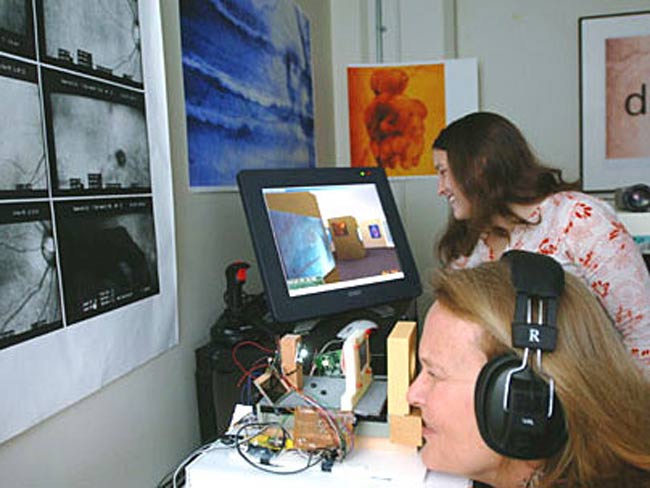Machine Offers Sight to Some Blind People

With her good eye, Elizabeth Goldring can distinguish between light and dark and see hand movement, but not individual fingers. She cannot recognize faces or read.
Goldring is an artist, a poet, and a senior fellow at the Massachusetts Institute of Technology's Center for Advanced Visual Studies. Her vision loss doesn't make any of these activities easier. She started losing her vision about 20 years ago. Today, after several surgeries, she has limited vision in her right eye, but is blind in the left.
Now Goldring and a team of eye doctors, fellow researchers, and students have produced a "seeing machine" that allows the visually challenged to view the face of a friend, access the Internet, and "previsit" unfamiliar buildings.
Starting from scratch
The project started 10 years ago when, to determine if Goldring had any healthy retina left, her doctors sent her to the Schepens Eye Research Institute at Harvard. Technicians there used a diagnostic device called a scanning laser opthamaloscope, or SLO, to look into her eyes.
The SLO projected a simple image of a stick-figure turtle past the hemorrhages inside her left eye that contributed to her blindness and directly onto the retina of one eye. She could see the turtle, but wanted more, and asked the technicians to project the word "sun."
"And I could see it," Goldring said. "That was the first time in several months that I'd seen a word, and for a poet that's an incredible feeling."
Get the world’s most fascinating discoveries delivered straight to your inbox.
Since then, Goldring has been working with other vision researchers and engineers to transform the $100,000 SLO into a more affordable machine. So far, by dumping some of the diagnostic equipment and replacing expensive lasers with cheaper light emitting diodes (LEDs), they have knocked the price down to $4,000.
The once bulky SLO now fits on a desktop while still being able to project images, video, and more onto a person's retina.
"We essentially made the new machine from scratch," Goldring said.
Real-time vision
Although still in the early stages of development, there is potential the machine could deliver real-time images to its user. Goldring has already successfully experimented with hooking it up to a video camera. But packing the whole contraption into a wearable, portable device could be especially difficult.
It's also possible that delivering real-time images—which are filled with complex shapes, movements, and colors—to a visually challenged person might be too much for them to handle.
"When we tried out the machine, I could see one face very well, but if more than one face got in the picture I could see nothing," Goldring told LiveScience. "It was too much, it was overload. If you're blind it's easy to get overload on these things."
Seeing is believing
After miniaturizing the SLO and developing her own "visual language"—consisting of short words that incorporate graphics and symbols to convey meaning and make the image easier to see and read—the next step was to offer the experience to others who could benefit.
"My dream, of course, is that it will get out of my laboratory and into the hands that people who can use it," Goldring said.
The pilot clinical trial included 10 participants with 20/70 vision or worse in their good eye. Most were clinically blind, meaning they can only make out the largest "E" on a standard eye chart, and had lost their vision from a variety of causes, including diabetes, macular degeneration, and visual field loss.
Using the modified machine, six of the participants interpreted all 10 "word-images" correctly. Several commented that even in its early stages, it was by far the best visual aid they had used.
"They responded really well to the visual language," Goldring said. "One woman told me she would love to see recipes written that way."
The results from the study, announced today, were reported earlier this year in Optometry, the Journal of the American Optometric Association.
Mass appeal
A device such as this could open doors to new, unfamiliar places, which the visually challenged are often terrified of visiting, Goldring said.
"There's a fear of missing simple visual cues, steps, and not being able to decipher elevator buttons," she said. "Stairs are, of course, quite scary to blind people."
Fewer than 10 percent of the blind read Braille, making it difficult to find their way in unfamiliar places, and directions from well-meaning bystanders are often inaccurate. Just a peek at the layout of the new building could be enough to help the blind find their way.
"If you are visually challenged, if you see something once using the machine, you remember," Goldring said.
The current model allows the user to travel through a virtual building using a joystick to move forward, backward, and sideways to get the lay of the land. The researchers are currently working on developing a color version of the machine for a large-scale clinical trial. The new version will allow the participants to stroll through a gallery containing artwork by Goldring.
